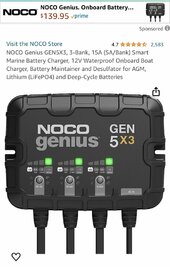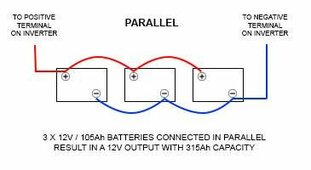Leonvilj
New Member
Hi all - I am new to the site and forum … I need some what I believe is simple help and recommendation!
I have a 2020 23ft Godfrey pontoon boat, Wilth a Honda VTEC 250 outboard. it came with 1 basic marine battery, (running all power, stereo, motor etc) which I removed and replaced now with 3 new Blue Top optima batteries. (pics below)
We boat in Arizona eight or nine months a year & primarily went with 3 of these AGM batteries so we could run the stereo for hours on the water.
I also added NOCO GENESIS 3 bank 15A (5A per charger) onboard charger, connecting all 3 batteries. after getting off the lake at the end of the day and plugging this in, it usually has them up to 100% within a matter of minutes.
so essentially, it’s just a trickle charger keeping the batteries topped off.
Last season I have had power to plug it into to keep the batteries topped off. I would imagine they never drop below 10 or 15%. ( as again the onboard charger would have them up to 100% usually within a few minutes.)
I am in a predicament now storing the boat, and there is no power for the NOCO onboard charger to plug into
1. have started looking at some solar kits, with either a 100 W panel or possibly 2 of those for 200 W( again this is not a use application of charging the batteries from being very low all the way up… I would imagine it’s just gonna top them up 10 or 15% to hit 100% charge)
2. it seems also i’m needing a charge controller… although I’m not sure size, etc. and
3. then i’m not certain but I am wanting to confirm if that charge controller needs to be connected to an additional good capacity battery? And if so, what size etc.
and then
4. Then I imagine from that battery and essentially want to confirm if I would need an inverter and if an inverter would work so that I can plug-in. AC plug from the onboard 3 battery NOCO charger ? if so size inverter. ?
** basically would ‘Solar panel - Charge controller - battery - inverter’ work??
The onboard charger regulates under charging and overcharging when plugged directly into the wall so I assume it would still do the same with an inverter!?
appreciate anyone with specific recommendations and products- looking to do as low-cost as possible as again this is not a primary charging unit!
cheers Leon
I have a 2020 23ft Godfrey pontoon boat, Wilth a Honda VTEC 250 outboard. it came with 1 basic marine battery, (running all power, stereo, motor etc) which I removed and replaced now with 3 new Blue Top optima batteries. (pics below)
We boat in Arizona eight or nine months a year & primarily went with 3 of these AGM batteries so we could run the stereo for hours on the water.
I also added NOCO GENESIS 3 bank 15A (5A per charger) onboard charger, connecting all 3 batteries. after getting off the lake at the end of the day and plugging this in, it usually has them up to 100% within a matter of minutes.
so essentially, it’s just a trickle charger keeping the batteries topped off.
Last season I have had power to plug it into to keep the batteries topped off. I would imagine they never drop below 10 or 15%. ( as again the onboard charger would have them up to 100% usually within a few minutes.)
I am in a predicament now storing the boat, and there is no power for the NOCO onboard charger to plug into
1. have started looking at some solar kits, with either a 100 W panel or possibly 2 of those for 200 W( again this is not a use application of charging the batteries from being very low all the way up… I would imagine it’s just gonna top them up 10 or 15% to hit 100% charge)
2. it seems also i’m needing a charge controller… although I’m not sure size, etc. and
3. then i’m not certain but I am wanting to confirm if that charge controller needs to be connected to an additional good capacity battery? And if so, what size etc.
and then
4. Then I imagine from that battery and essentially want to confirm if I would need an inverter and if an inverter would work so that I can plug-in. AC plug from the onboard 3 battery NOCO charger ? if so size inverter. ?
** basically would ‘Solar panel - Charge controller - battery - inverter’ work??
The onboard charger regulates under charging and overcharging when plugged directly into the wall so I assume it would still do the same with an inverter!?
appreciate anyone with specific recommendations and products- looking to do as low-cost as possible as again this is not a primary charging unit!
cheers Leon





